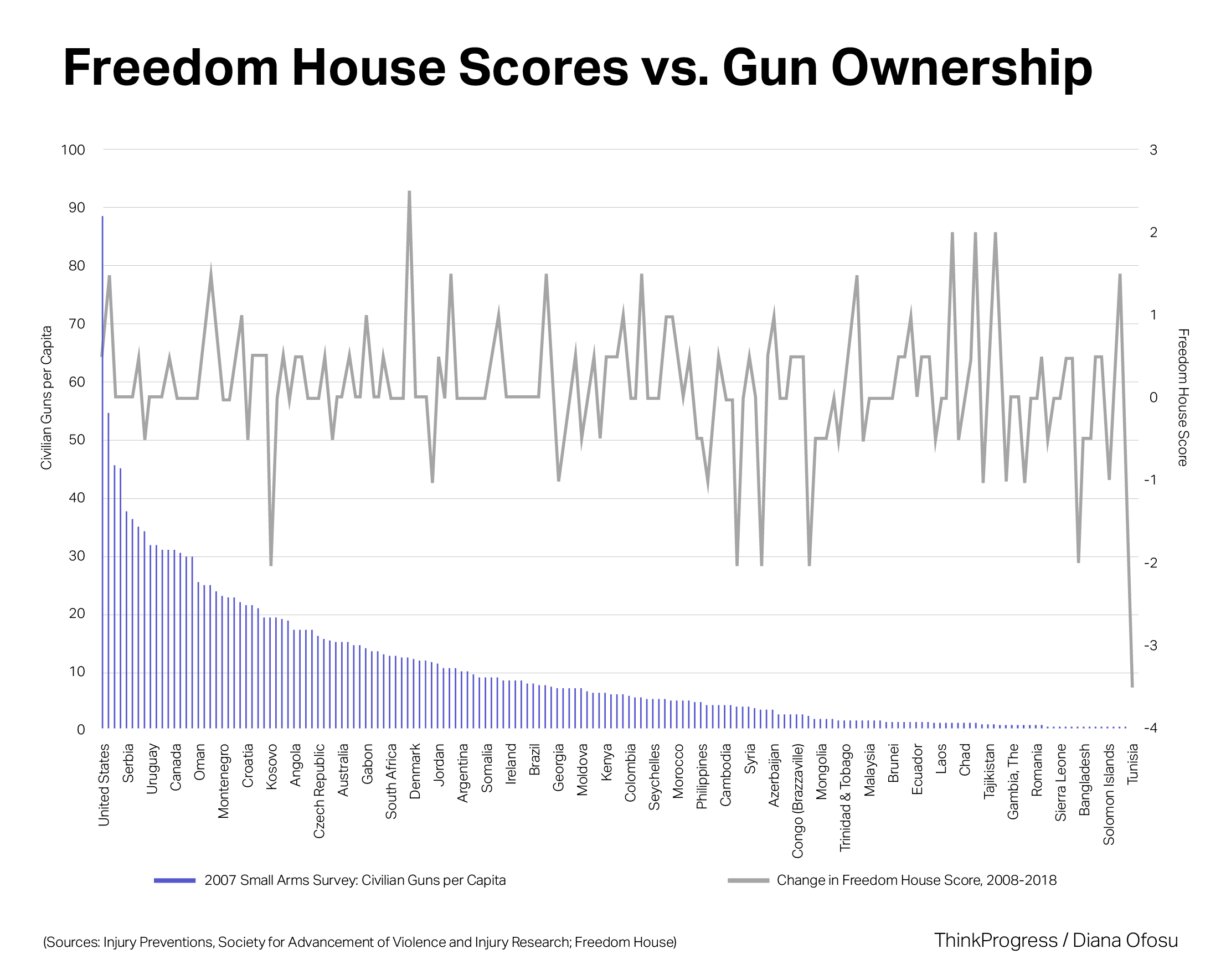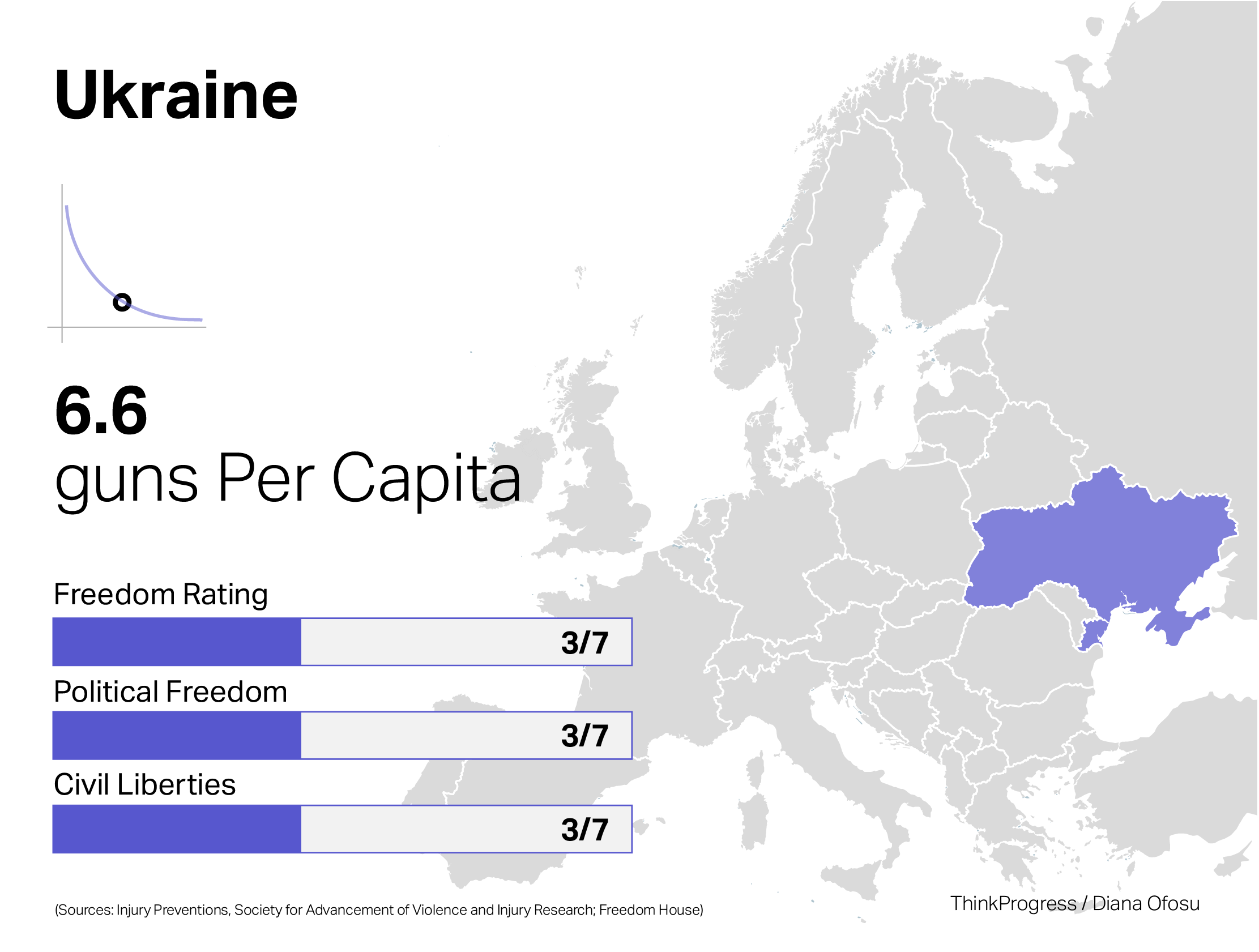Whenever there’s a sign of potential gun reform on the horizon, gun rights evangelists — especially among the more extreme fringe — fall back on an oft-repeated claim: that civilian gun ownership is the only thing keeping tyranny at bay.
“The purpose of the Second Amendment is to give people the means to overthrow the government in the event it becomes tyrannical,” according to The Federalist’s John Daniel Davidson. The Second Amendment “has just as much to do with the people protecting themselves from tyranny as it does burglars,” says Red State’s Erick Erickson. Or as Harlon Carter, former president of the National Rifle Association (NRA), memorably quipped, allowing dangerous individuals access to guns is the “price we pay for freedom.”
There is, of course, a clear link between the Second Amendment and freedom, insofar as it permits freedoms for individuals to purchase and bear arms in the United States. As Pew found last year, some three-quarters of gun owners say the right to civilian gun ownership is “essential” to “their own personal sense of freedom.”
But is the right to civilian gun ownership also essential to the prevention of tyranny? Is it a key ingredient to the preservation, implementation, and extension of democracy?
The short answer: No. Data compiled by ThinkProgress from the past decade shows no correlation between civilian gun ownership rates and democracy — or low civilian gun ownership rates and the rise of a tyrannical government.
Myths and reality
In theory, it’s easy to see why high rates of civilian gun ownership would correlate with democracy, and why it would help prevent democratic backsliding. After all, what government would attempt to implement tyrannical policies — say, interning its own citizens based on their ethnicity, or preventing wide segments of the public from the right to vote based on their race — if it knew an armed citizenry could stand in the way?
“White supremacists are absolutely correct in pointing to the Second Amendment as having been created for their supremacy in perpetuity, so that what they regarded as ‘tyranny’ was and is any deviance by government from that arrangement.”
Of course, these despotic practices have already played out in American history. The Second Amendment did little to prevent American governments from creating internment camps for Americans of Japanese descent or from enacting Jim Crow laws, repeatedly calling the country’s claims to liberal democracy into question. “White supremacists are absolutely correct in pointing to the Second Amendment as having been created for their supremacy in perpetuity, so that what they regarded as ‘tyranny’ was and is any deviance by government from that arrangement,” Roxanne Dunbar-Ortiz, the author of Loaded, a recent history of the Second Amendment, told ThinkProgress.
If anything, over the first two centuries of its existence, the U.S. was something closer to a constitutional oligarchy, or a restricted democracy. American governments, both federal and state, managed to disenfranchise any number of populations throughout U.S. history: African-, Asian-, and Hispanic-Americans; Americans aged 18-21; women.
Even with the Second Amendment in place, forms of tyranny, suffocating rights of minorities and women alike, reigned.
More fake quotes from Founding Fathers supposedly claiming the Second Amendment was to be the last, best defense against tyranny: https://t.co/HOgtU5sXFK pic.twitter.com/MugPscv0GX
— Casey Michel (@cjcmichel) April 23, 2018
Another fake quote. This time (not) from George Washington. https://t.co/dYT0TbkOvk pic.twitter.com/bwA8NATDs0
— snopes.com (@snopes) January 7, 2016
Indeed, data compiled by ThinkProgress finds that this theoretical relationship between gun ownership and democracy doesn’t actually hold. And if recent history is any indication, there’s little actual relationship between civilian gun ownership and the prevention of tyranny.
In examining international rates of civilian gun ownership, compiled by the Small Arms Survey, and democratization data from Freedom House, which assesses political freedom and civil liberties, the relationship between the two over the past decade appears negligible. (Disclosure: This reporter has worked with Freedom House in the past.)

The data shows no significant correlation between high civilian gun ownership rates and countries that have improved their democracy scores over the past decade. Nor is there a significant correlation between countries with low civilian gun ownership rates and those that have seen democratic backsliding.
Democracy’s friends, democracy’s foes
The findings back up previous studies on the supposed link between civilian arms and democratic freedoms. As Jan Amo Hessbruegge, who works for the UN’s High Commissioner for Human Rights, wrote in 2017, “Research does not establish a clear correlation between private gun ownership levels and the relative political freedom of a particular country.”
And in looking at data from 2013, The Atlantic found that the relationship between democracy and civilian gun ownership rates was “observable, but minor.” One analyst called the link “baloney.”
ThinkProgress’ analysis, however, looks at the democratization data over the past decade, rather than a snapshot from a single year.
In assessing data from 2008-2018, civilian gun ownership rates appear to have no influence on the strength of a country’s democracy.
For instance, five of the six countries with the greatest democratic improvements over the past decade are located among the bottom half of countries in terms of civilian arms rates. At the same time, six of the 11 countries with the greatest democratic backsliding have also been in the bottom half in terms of gun ownership rates. (For Freedom House, a lower score on its democracy index is better in terms of democratization; those with the highest scores are considered dictatorships.)
Look at Fiji and Ethiopia, for instance. In 2008, both had identical Freedom House scores, with nearly identical civilian arms ownership rates (Fiji has 0.5 guns per 100 civilians, while Ethiopia has 0.4). But a decade later, Fiji was far freer, boasting democracy scores comparable to Colombia and Montenegro, whereas Ethiopia was suffering under a far bloodier regime than it is now, scoring worse than dictatorships like Kazakhstan and Belarus.


There’s even indication that, over the past decade, countries with low civilian arms rates may be likelier to improve their democratic scores; among the 10 countries with the lowest civilian gun ownership rates, five have improved their democratization scores since 2008. But among the 10 countries with the highest gun ownership rates, three — including the U.S. — have actually gotten worse.
The country with the largest improvement in democracy scores over the past decade is Tunisia. According to Small Arms Survey’s data from 2007, the most recent numbers available, Tunisia has the lowest civilian arms rate in the entire world, at only 0.1 gun per 100 individuals.
Revolution
Of course, many advocates of the theory that civilian gun ownership can prevent tyrannical governments from taking root wouldn’t point to incremental democratic decay — the creeping illiberalism that has spread in Hungary or Poland over the past few years, for instance. Rather, they’d point to the potential for a heavily armed citizenry to overthrow a tyranny that’s already taken root.
“I don’t think guns played any significant role in what happened.”
But again, if data from the past decade is any indication, the relationship between civilian gun ownership and successful revolution is negligible. Yemen, with the second-highest civilian arms rate in the world, boasts lower democracy scores than dictatorships like China, Cuba, and Iran. Saudi Arabia, with the seventh-highest rate of civilian arms ownership, remains a petro-state theocracy.
Put another way, the only country among the 80 nations with the highest civilian arms rates that has successfully overthrown a domestic dictatorship over the past decade is Libya. Venezuela, Bahrain, and Russia — all countries with higher civilian arms rates than Libya, and all of which saw notable anti-regime protests over the past decade — have seen their opposition effectively snuffed out.
Or look at the most notable revolutionary development over the past half-decade: Ukraine, where protesters in early 2014 overthrew the thuggish regime of Viktor Yanukovych. Ukraine, according to Small Arms Survey, had the 83rd-highest civilian arms rate globally, between the U.K. (ranked Free by Freedom House) and the Maldives (ranked Not Free by Freedom House).
For observers of Ukraine’s EuroMaidan revolution, the role of civilian arms ownership in toppling Yanukovych was, at best, scant. “What was most important [to toppling Yanukovych] was the fact that a large cross-section of society rejected what Yanukovych and his oligarchy stood for,” Yuri Shevchuk, an expert on Ukrainian politics at Columbia University, told ThinkProgress. “I don’t think guns played any significant role in what happened.”

America’s stories
There are no parallel democratization scores for U.S. states, or at least anything as exhaustive as Freedom House’s international rankings. But the lack of correlation between gun ownership and democracy seems to extend to American states; in fact, it may even correlate with higher rates of anti-democratic forces.
For instance, among the nine states that were, until 2013, subject to federal pre-clearance provisions on voting — thanks in part to their history of preventing minorities from voting — over half are among the 13 states with the highest rates of gun ownership. This includes Alaska, which, at least as recently as 2015, had the highest civilian arms rate of any state in the country.
Likewise, most of the states that barred same-sex marriage until 2015 were among the 20 states with the highest gun ownership rates.
The idea that a heavily armed citizenry can and will prevent the imposition of tyranny is understandable — but it’s facile, and false. After all, armed uprisings didn’t bring down the Soviet Union, or budding kleptocracies in Georgia or Kyrgyzstan, or dictatorships in Egypt and Romania and South Korea. It wasn’t an armed citizenry that finally brought down Serbia’s Slobodan Milosevic. It wasn’t gun-toting protesters that forced Armenian Prime Minister Serzh Sargsyan to step down just this month.
Peaceful, homegrown protests toppled Armenia's long-serving leader on April 23 https://t.co/RTjXGltQmg
— Eurasianet (@EurasiaNet) April 23, 2018
After 10 days of peaceful protests led by opposition leader Nikol Pashinyan with crowds up to 100,000 people on the streets, the people of Armenia have managed to get Prime Minister of Armenia Serzh Sargsyan to RESIGN. This is incredible, this is unprecedented #rejectserzh
— Liana Aghajanian (@LianaAgh) April 23, 2018
If anything, this idea seems to be one that deviates simply from the story we tell ourselves about the success of the American Revolution — or, more regionally, the success of the Texas Revolution. It’s a story that claims civilian arms — the firepower of regular citizen-farmers, citizen-yeomen, citizen-soldiers — were the key to victory over King George III or Santa Anna. It’s a great story, sure, and like all great stories, it has persisted to this day. But it’s a story that elides the decisive role that other factors played, most especially the role of foreign actors, whether in Paris (for the Americans) or Washington (for the Texans).
And it’s a story that ignores the far more important role that mass turnout, press freedoms, and minority rights play in the overthrow of anti-democratic regimes. As Xavier Marquez wrote in Non-Democratic Politics, protest campaigns involving more than 4 percent of the population’s participation “almost always” succeed. Arms are beside the point.
This notion is, in the end, a myth — one that will do little to slow the democratic backsliding we’ve already witnessed, or prevent the imposition of a tyrannical government so long feared.

